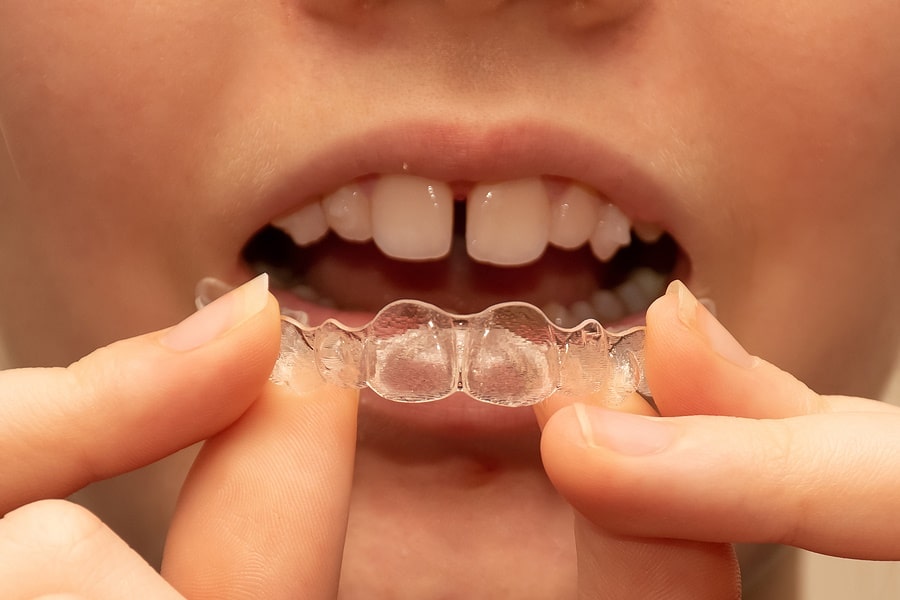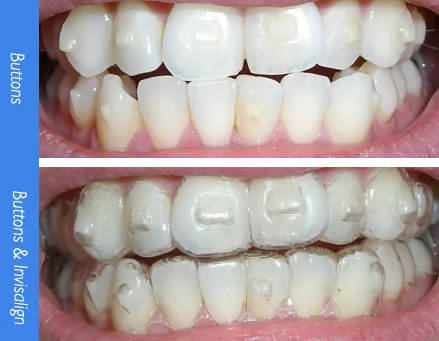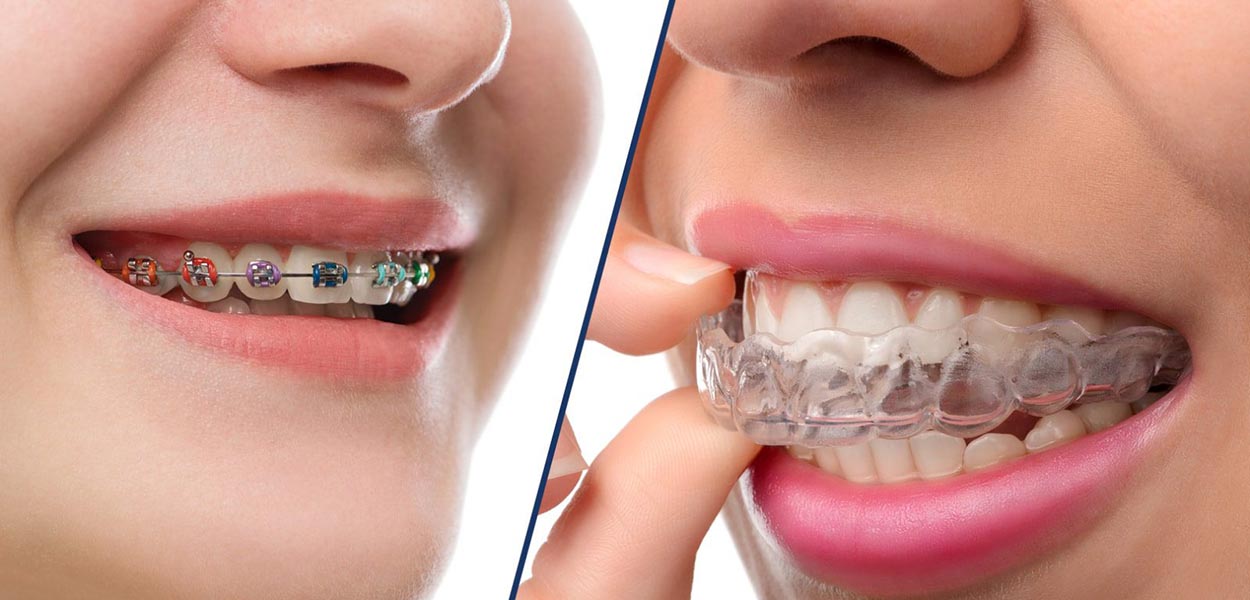The Ultimate Comparison: Invisalign vs. Traditional Dental braces for Adults
The Ultimate Comparison: Invisalign vs. Traditional Dental braces for Adults
Blog Article
Invisalign vs. Standard Dental braces: Which Choice Is Right for You?
When thinking about orthodontic treatment, the choice in between Invisalign and standard braces presents numerous crucial aspects that merit mindful analysis. Invisalign uses a discreet alternative with detachable aligners, while standard braces give a much more visible yet reliable option for serious imbalance.
Introduction of Treatment Alternatives

On the other hand, traditional braces consist of steel braces and wires that are bound to the teeth. This technique uses continuous pressure gradually to attain alignment. While efficient for complicated orthodontic concerns, traditional braces need normal gos to for modifications and can present obstacles in maintaining oral hygiene because of the problem of cleaning up about braces and cords.
Both options have their benefits, and the option commonly rests on details oral problems, way of living choices, and patient compliance. Ultimately, speaking with an orthodontic expert is important for figuring out one of the most appropriate treatment plan tailored to individual needs. Understanding the subtleties of each alternative can dramatically affect the total success of orthodontic treatment.
Aesthetic Considerations
A significant factor affecting the selection in between Invisalign and standard braces is the aesthetic allure each therapy uses. Invisalign aligners are crafted from clear plastic, making them practically invisible when worn. This very discreet appearance is particularly appealing to teenagers and grownups that may really feel uneasy regarding their orthodontic treatment. The capacity to preserve a natural smile throughout the placement process can significantly boost the individual's confidence in social and professional settings.
On the other hand, typical braces include steel brackets and cables, which can be a lot more recognizable. While improvements in orthodontic technology have actually resulted in the growth of smaller braces and colored elastics, standard dental braces still preserve an even more conspicuous account. For some people, the visibility of dental braces may discourage them from looking for required therapy.
Inevitably, the option in between Invisalign and traditional braces might rest on personal preferences pertaining to aesthetic appeals. Patients who prioritize discernment often lean toward Invisalign, while those that are much less concerned about exposure might go with traditional braces. Comprehending the visual effects of each option is important for making an educated choice that aligns with one's lifestyle and preferences.
Comfort and Convenience

In terms of ease, Invisalign aligners are removable, enabling individuals to enjoy their favored foods without limitation and maintain optimum dental hygiene. Cleaning and flossing are simplified, as the aligners can be taken out throughout these routines, whereas typical braces require cautious maneuvering around braces and cables.
Additionally, Invisalign's dynamic system enables fewer orthodontic check outs. Patients generally useful reference receive several collections of aligners at the same time, which can improve the treatment process and minimize time invested in the orthodontist's chair. On the other hand, standard dental braces demand routine changes, making them much less convenient for those with active timetables. Invisalign. On the whole, the comfort and benefit of Invisalign make it an appealing option for numerous people you could check here seeking orthodontic therapy.
Treatment Period and Effectiveness
While both Invisalign and traditional braces work in dealing with dental misalignments, the period of treatment can vary substantially between the 2 choices. Usually, Invisalign therapy can take anywhere from 12 to 18 months, relying on the complexity of the case. The clear aligners work by slowly changing teeth right into their preferred placements, and normal follow-ups with an orthodontist aid ensure progression stays on track.
In comparison, traditional dental braces often call for a longer dedication, normally ranging from 18 months to 3 years. This is visit this website because of their set nature and making use of cables and braces, which can be much more effective for severe imbalances and intricate cases (Invisalign). The treatment efficiency of conventional dental braces is well-documented, as they enable precise adjustments and higher control over tooth movement
Inevitably, the choice between Invisalign and typical braces might hinge on both the anticipated therapy duration and the certain dental problems available. Consulting with an orthodontist is crucial, as they can give tailored recommendations based on private requirements, making certain the chosen technique lines up with desired results and timeframes.
Expense Contrast and Insurance Coverage Alternatives
Expense plays a significant function in the decision-making process for individuals thinking about orthodontic treatment, whether choosing for Invisalign or conventional braces. On standard, the expense of Invisalign ranges from $3,000 to $8,000, while conventional dental braces typically set you back between $2,000 and $6,000. Factors influencing these prices include the complexity of the case, the period of therapy, and geographical place.
Lots of dental insurance coverage strategies provide partial protection for orthodontic treatments, however the specifics can vary extensively. Generally, traditional dental braces may be a lot more often covered by insurance coverage strategies compared to Invisalign, which some insurance firms classify as an aesthetic treatment.
Additionally, numerous orthodontic practices offer versatile settlement plans, making both treatment alternatives extra easily accessible. Clients need to ask about potential financing choices and discount rates for upfront repayments. Assessing the complete price, consisting of insurance policy advantages and layaway plan, is crucial for making an educated decision that straightens with both aesthetic choices and budget plan factors to consider.

Verdict
In summary, the option between Invisalign and traditional dental braces hinges on numerous aspects, including aesthetic preferences, convenience, treatment period, and expense. Invisalign supplies a very discreet, detachable alternative that facilitates oral hygiene and dietary flexibility, while traditional braces may be a lot more ideal for complex dental problems and commonly come with a reduced rate point. Eventually, assessment with an orthodontist is vital to examine private circumstances and determine the most suitable treatment option for attaining optimum dental placement.
When considering orthodontic therapy, the selection between Invisalign and standard braces provides numerous crucial elements that warrant mindful evaluation.Contrasting Invisalign and standard braces discloses distinctive treatment choices for orthodontic improvement.While both Invisalign and typical dental braces are effective in fixing oral imbalances, the duration of treatment can vary considerably between the two choices.Expense plays a significant role in the decision-making process for individuals considering orthodontic therapy, whether opting for Invisalign or traditional dental braces.In recap, the choice between Invisalign and conventional braces pivots on several factors, including visual preferences, convenience, treatment period, and cost.
Report this page